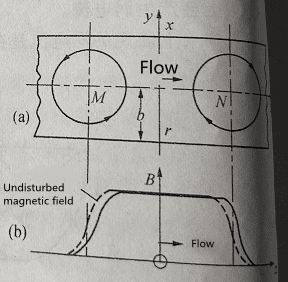The conductivity of liquid metal is several orders of magnitude higher than the conductivity of the best non-metallic conductive liquids. The appearance of the skin effect makes the edge effect of the magnetic field more complicated, and the influence of the eddy current becomes greater when the flowmeter with AC excitation is used.
It can be seen from the figure that the eddy current generated by the edge effect of the magnetic poplar causes the secondary magnetic flux to distort the edge area of the working magnetic field. Suppose that the eddy current M on the left has a demagnetization effect so that the magnetic field in the edge area is weakened; the eddy current on the right will increase the magnetic field in the edge area instead.
Although the above-mentioned effect has a certain influence in the case of DC excitation, it is not a big problem. If AC excitation is used, with the increase of the excitation current frequency, the influence of this edge effect will be more serious.

The measured fluid medium contains magnetic materials, such as metals such as iron, nickel, and cobalt, and the edge effect of the magnetic field is more complicated. When studying this effect theoretically, Rm “magnetic Reynolds number” is usually used to characterize the influence of this effect (just like the Reynolds number is used to characterize fluid flow in fluid mechanics). Magnetic Reynolds number Rm = μσῡa, where μ and σ are the permeability and conductivity of the medium, respectively, ῡ is the average flow velocity, and a is the radius of the measuring tube.
Theoretical research and experimental results prove that if the value of Rm is not large and the edge of the magnetic field is not too close to the electrode, even if it contains a small amount of magnetically conductive material, the impact on the measurement can still be ignored.
On the contrary, if the value of Rm is large and the edge of the magnetic field is relatively close to the electrode, the working magnetic field will be distorted, which will cause serious nonlinearity in the measurement. With the increase of the content of the magnetic material, the value of Rm increases, and the air gap reluctance and magnetic flux of the working magnetic field are changed. This is not just a problem of the edge effect of the magnetic field.
